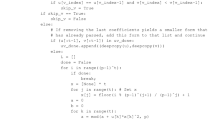Abstract
For every bivariate polynomial \(p(z_1, z_2)\) of bidegree \((n_1, n_2)\), with \(p(0,0)=1\), which has no zeros in the open unit bidisk, we construct a determinantal representation of the form
where \(Z\) is an \((n_1+n_2)\times (n_1+n_2)\) diagonal matrix with coordinate variables \(z_1\), \(z_2\) on the diagonal and \(K\) is a contraction. We show that \(K\) may be chosen to be unitary if and only if \(p\) is a (unimodular) constant multiple of its reverse. Furthermore, for every bivariate real-zero polynomial \(p(x_1, x_2),\) with \(p(0,0)=1\), we provide a construction to build a representation of the form
where \(A_1\) and \(A_2\) are Hermitian matrices of size equal to the degree of \(p\). A key component of both constructions is a stable factorization of a positive semidefinite matrix-valued polynomial in one variable, either on the circle (trigonometric polynomial) or on the real line (algebraic polynomial).
Similar content being viewed by others
Notes
We note that a less common terminology was used in Grinshpan et al. (2013): stable polynomials were called semi-stable, and strongly stable polynomials were called stable.
To see that this assumption is indeed generic, notice first that it means that all the roots of the resultant determinant \(r(z_1)\) of \(p(z_1,\cdot )\) and \(\overleftarrow{p}(z_1,\cdot )\) are simple—i.e., the discriminant of \(r(z_1)\) is not zero—and that \(z_1=0\) is not a root of \(r(z_1)\), and second that the coefficients of \(r(z_1)\) are polynomials in the coefficients of \(p\) and of \(\overleftarrow{p}\), i.e., polynomials in the coefficients of \(p\) and in their conjugates.
Alternatively, one may use the formula
$$\begin{aligned} \frac{ p(z_1, z_2) \overline{p(1/\bar{z_1}, z_2 )} - \overleftarrow{p} (z_1, z_2) \overline{\overleftarrow{p} (1/\bar{z_1}, z_2 )}}{1-|z_2|^2} = v_{n_2-1}(z_2) Q(z_1) v_{n_2 -1} (z_2)^* \end{aligned}$$to come to the same conclusion. This formula can be easily checked by hand, but also appears in many sources; see, e.g., (Kailath et al. (1978), Section 4).
Alternatively, we can prove that a zero \(a\) of \(P(x_2)\) is not a pole of \(M(x_2)\) similarly to the proof of the claim in the proof of Theorem 2.1. It is well known that \(\det B(a) = 0\) if and only if the polynomials \(\check{p}_{a}\) and \(\check{q}_{a}\) have a common zero \(\lambda \); let us assume that \(\lambda \) is a simple zero of both \(\check{p}_{a}\) and \(\check{q}_{a}\), then it is also well known that the left kernel of \(B(a)\) is spanned by \(v_{d-1}(\lambda )\) (all these facts follow quite easily from (4.12)–(4.13)). Since \(B(a) = P(a) P(\bar{a})^*\), and since \(v_{d-1}(\lambda ) C(a) = \lambda v_{d-1}(\lambda )\), it follows that the one-dimensional left kernel of \(P(a)\) is the left eigenspace of \(C(a)\), implying as in the proof of Theorem 2.1 that \(a\) is not a pole of \(M(x_2)\).
References
Agler, J. (1990). On the representation of certain holomorphic functions defined on a polydisc. In Topics in operator theory: Ernst D. Hellinger Memorial Volume, Oper. Theory Adv. Appl. (vol. 48, pp. 47–66), Basel: Birkhäuser.
Agler, J., & McCarthy, J. E. (2005). Distinguished varieties. Acta Mathematica, 194(2), 133–153.
Arov, D. Z. (1979). Passive linear steady-state dynamical systems. (Russian), Sibirsk. Mat. Zh. 20(2), 211–228, 457.
Bakonyi, M., & Woerdeman, H. J. (2011). Matrix completions, moments, and sums of Hermitian squares. Princeton, NJ: Princeton University Press.
Ball, J. A. Gohberg, I., & Rodman, L. (1990). Interpolation of rational matrix functions. Operator theory: Advances and applications (vol. 45, xii+605 pp). Basel: Birkhäuser Verlag.
Ball, J. A. Sadosky, C., & Vinnikov, V. (2005). Scattering systems with several evolutions and multidimensional input/state/output systems. Integral Equations Operator Theory, 52(3), 323–393.
Ball, J. A., & Vinnikov, V. (1996). Zero-pole interpolation for matrix meromorphic functions on an algebraic curve and transfer functions of 2D systems. Acta Applicandae Mathematica, 45, 239–316.
Ball, J. A., & Vinnikov, V. (1999). Zero-pole interpolation for meromorphic matrix functions on a compact Riemann surface and a matrix Fay trisecant identity. American Journal of Mathematics, 121, 841–888.
Bart, H. Gohberg, I., & Kaashoek, M. A. (1979). Minimal factorization of matrix and operator functions. Operator Theory: Adv. Appl. (vol. 1). Basel-Boston, MA: Birkhäuser Verlag.
Basu, S., & Fettweis, A. (1987). New results on stable multidimensional polynomials. II. Discrete case. IEEE Transactions on Circuits and Systems, 34, 1264–1274.
Borcea, J., Brändén, P., & Liggett, T. M. (2009). Negative dependence and the geometry of polynomials. Journal of the American Mathematical Society, 22(2), 521–567.
Cole, B. J., & Wermer, J. (1999). Ando’s theorem and sums of squares. Indiana Univesity Mathematics Journal, 48(3), 767–791.
Doyle, J. C. (1982). Analysis of feedback systems with structured uncertainties. Proceedings of the IEE-D 129(6), 242–250.
Dritschel, M. A., & Rovnyak, J. (2010). The operator Fejér–Riesz theorem. Operator Theory: Advanced Applications, 207, 223–254.
Dubrovin, B. A. (1983). Matrix finite zone operators. Contemporary Problems of Mathematics (Itogi Nauki i Techniki), 23, 33–78 (Russian).
Fulton, W. (1969). Algebraic curves. Mathematics lecture note series. New York-Amsterdam: W.A. Benjamin.
Gårding, L. (1951). Linear hyperbolic partial differential equations with constant coefficients. Acta Mathematica, 85, 2–62.
Gårding, L. (1959). An inequality for hyperbolic polynomials. Journal of Mathematics and Mechanics, 8, 957–965.
Geronimo, J. S., Iliev, P., & Knese, G. (2013). Polynomials with no zeros on a face of the bidisk. arXiv:1301.3510.
Geronimo, J. S., & Woerdeman, H. J. (2004). Positive extensions, Fejér–Riesz factorization and autoregressive filters in two variables. Annals of Mathematics (2), 160(3), 839–906.
Geronimo, J. S., & Woerdeman, H. J. (2006). Two-variable polynomials: Intersecting zeros and stability. IEEE Transactions on Circuits Systems, 53(5), 1130–1139.
Ghamgui, M., Yeganefar, N., Bachelier, O., & Mehdi, D. (2013). Robust stability of hybrid Roesser models against parametric uncertainty: A general approach. Multidimensional Systems and Signal Processing, 24(4), 667–684.
Givone, D. D., & Roesser, R. P. (1972). Multidimensional linear iterative circuits-general properties. IEEE Transactions on Computers, 21, 1067–1073.
Grant, M., & Boyd, S. (2008). Graph implementations for nonsmooth convex programs. In V. Blondel, S. Boyd, & H. Kimura (eds.), Recent advances in learning and control (a tribute to M. Vidyasagar), Lecture Notes in Control and Information Sciences (pp. 95–110). Berlin: Springer. http://stanford.edu/boyd/graph_dcp.html.
Grant, M., & Boyd, S. (September 2013). CVX: Matlab software for disciplined convex programming, version 2.0 beta. http://cvxr.com/cvx.
Grinshpan, A., Kaliuzhnyi-Verbovetskyi, D. S., & Woerdeman, H. J. (2013). Norm-constrained determinantal representations of multivariable polynomials. Complex Analysis and Operator Theory, 7, 635–654.
Gurvits, L. (2008). Van der Waerden/Schrijver–Valiant like conjectures and stable (aka hyperbolic) homogeneous polynomials: one theorem for all. With a corrigendum. Electronics Journal of Combinatorics, 15(1), Research Paper 66, 26 pp.
Hachez, Y., & Woerdeman, H. J. (2007). The Fischer–Frobenius transformation and outer factorization. Operator theory, structured matrices, and dilations (pp. 181–203), Theta Ser. Adv. Math., 7, Theta, Bucharest.
Hanselka, C. (in preparation). Ph.D. Thesis, University of Konstanz.
Helton, J. W., & Vinnikov, V. (2007). Linear matrix inequality representation of sets. Communications on Pure and Applied Mathematics, 60, 654–674.
Henrion, D. (2010). Detecting rigid convexity of bivariate polynomials. Linear Algebra Applications, 432, 1218–1233.
Horn, A. (1954). On the eigenvalues of a matrix with prescribed singular values. Proceedings of the American Mathematical Society, 5, 4–7.
Horn, R. A., & Johnson, C. R. (1991). Topics in matrix analysis (viii+607 pp). Cambridge: Cambridge University Press.
Kailath, T., Vieira, A., & Morf, M. (1978). Inverses of Toeplitz operators, innovations, and orthogonal polynomials. SIAM Review, 20, 106–119.
Kalman, R. E. Falb, P. L., & Arbib, M. A. (1969). Topics in mathematical system theory (xiv+358 pp). New York-Toronto, Ont.-London: McGraw-Hill.
Kerner, D., & Vinnikov, V. (2012). Determinantal representations of singular hypersurfaces in \({\mathbb{P}}^n\). Advances in Mathematics, 231, 1619–1654.
Knese, G. (2008). Bernstein–Szegő measures on the two-dimensional torus. Indiana University Mathematics Journal, 57(3), 1353–1376.
Knese, G. (2010). Polynomials defining distinguished varieties. Transactions on American Mathematics Society, 362(11), 5635–5655.
Krein, M. G., & Naimark, M. A. (1936). The method of symmetric and Hermitian forms in the theory of the separation of the roots of algebraic equations. Kharkov. English translation (by O. Boshko and J. L. Howland): Lin. Mult. Alg. 10:265–308, 1981.
Kummer, M., Plaumann, D., & Vinzant, C. (2012). Hyperbolic polynomials, interlacers, and sums of squares. arXiv:1212.6696.
Kummert, A. (1989). Synthesis of two-dimmensional lossless \(m\)-ports with prescribed scattering matrix. Circuits Systems, Signal Processing 8(1), 97–119.
Kummert, A. (1990). A parametric representation for \(k\)-variable Schur polynomials. IEEE Transactions on Circuits Systems, 37(10), 1288–1291.
Kummert, A. (2002). 2-D stable polynomials with parameter-dependent coefficients: generalizations and new results. IEEE Transactions on Circuits Systems I: Fundamental Theory Applications, 49, 725–731.
Lancaster, P., & Tismenetsky, M. (1985). The theory of matrices. Computer science and applied mathematics (2nd ed.). Orlando, FL: Academic Press Inc.
Lewis, A. S., Parrilo, P. A., & Ramana, M. V. (2005). The Lax conjecture is true. Proceedings of the American Mathematics Society, 133, 2495–2499.
Leykin, A., & Plaumann, D. (2012). Determinantal representations of hyperbolic curves via polynomial homotopy continuation. arXiv:1212.3506.
Li, L., Xu, L., & Lin, Z. (2013). Stability and stabilisation of linear multidimensional discrete systems in the frequency domain. International Journal of Control, 86(11), 1969–1989.
Netzer, T., Plaumann, D., & Schweighofer, M. (2010). Exposed faces of semidefinitely representable sets. SIAM Journal on Optimization, 20, 1944–1955.
Netzer, T., Plaumann, D., & Thom, A. (2013). Determinantal representations and the Hermite matrix. Michigan Mathematics Journal, 62, 407–420.
Netzer, T., & Thom, A. (2012). Polynomials with and without determinantal representations. Linear Algebra Applications, 437, 1579–1595.
Nuij, W. (1968). A note on hyperbolic polynomials. Mathematica Scandinavica, 23, 69–72.
Plaumann, D., Sturmfels, B., & Vinzant, C. (2011). Quartic curves and their bitangents. Journal of Symbolic Computation, 46, 712–733.
Plaumann, D., Sturmfels, B., Vinzant, C. (2012). Computing linear matrix representations of Helton–Vinnikov curves. Operator Theory: Adv. Appl. 222 (Festschrift in honor of J. William Helton) (pp. 259–277).
Plaumann, D., & Vinzant, C. (2013). Determinantal representations of hyperbolic plane curves: An elementary approach. Journal of Symbolic Computation, 57, 48–60.
Ramana, M., & Goldman, A. J. (1995). Some geometric results in semidefinite programming. Journal of Global Optimization, 7, 33–50.
Renegar, J. (2006). Hyperbolic programs, and their derivative relaxations. Foundations of Computational Mathematics, 6, 59–79.
Rosenblatt, M. (1958). A multi-dimensional prediction problem. Arkiv för Matematik, 3, 407–424.
Rosenblum, M., & Rovnyak, J. (1985). Hardy classes and operator theory. Oxford Mathematical Monographs. New York: Oxford Science Publications/The Clarendon Press/Oxford University Press.
Rudin, W. (1969). Function theory on polydiscs. New York-Amsterdam: W. A. Benjamin Inc.
Scheicher, M. (2013). Robustly stable multivariate polynomials. Multidimensional Systems and Signal Processing, 24(1), 23–50.
Speyer, D. (2005). Horn’s problem, Vinnikov curves, and the hive cone. Duke Mathematical Journal, 127(3), 395–427.
Vinnikov, V. (1989). Complete description of determinantal representations of smooth irreducible curves. Linear Algebra Applications, 125, 103–140.
Vinnikov, V. (1993). Self-adjoint determinantal representions of real plane curves. Mathematische Annalen, 296, 453–479.
Vinnikov, V. (2012). LMI representations of convex semialgebraic sets and determinantal representations of algebraic hypersurfaces: Past, present, and future. Operator Theory: Adv. Appl. 222 (Festschrift in honor of J. William Helton) (pp. 325–349).
Wagner, D. G. ( 2011). Multivariate stable polynomials: Theory and applications. Bulletin of the American Mathematical Society, 48(1), 53–84.
Woerdeman, H. J. (2013). Determinantal representations of stable polynomials. Operator Theory: Advanced Applications, 237, 241–246.
Xu, L., Fan, H., Lin, Z., & Bose, N. K. (2008). A direct-construction approach to multidimensional realization and LFR uncertainty modeling. Multidimensional Systems and Signal Processing, 19(3–4), 323–359.
Yakubovich, V. A. (1970). Factorization of symmetric matrix polynomials. (English) Sov. Math., Dokl., 11, 1261–1264; translation from Dokl. Akad. Nauk SSSR, 194:532–535, 1970.
Acknowledgments
The authors wish to thank Greg Knese for helpful comments. Victor Vinnikov would like to thank Forschungsschwerpunkt Reelle Geometrie und Algebra at the University of Konstanz for its hospitality, and its members, especially Christoph Hanselka, Daniel Plaumann, and Markus Schweighofer, for useful discussions.
Author information
Authors and Affiliations
Corresponding author
Additional information
A.G., D.K.-V., H.W. were partially supported by NSF Grant DMS-0901628. D.K.-V. and V.V. were partially supported by BSF Grant 2010432. V.V. was partially supported by the Institute for Mathematical Sciences of the National University of Singapore within the framework of the program “Inverse Moment Problems: the Crossroads of Analysis, Algebra, Discrete Geometry and Combinatorics”.
Rights and permissions
About this article
Cite this article
Grinshpan, A., Kaliuzhnyi-Verbovetskyi, D.S., Vinnikov, V. et al. Stable and real-zero polynomials in two variables. Multidim Syst Sign Process 27, 1–26 (2016). https://doi.org/10.1007/s11045-014-0286-3
Received:
Revised:
Accepted:
Published:
Issue Date:
DOI: https://doi.org/10.1007/s11045-014-0286-3




